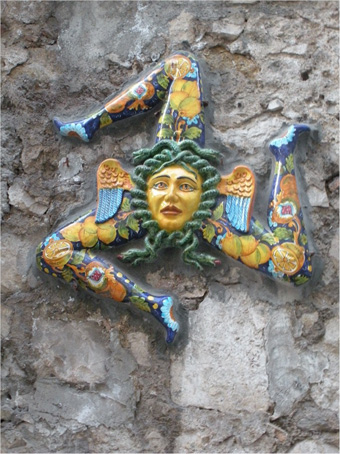Travel & Culture
Sicilia
I have finally given up the idea, after several failed attempts, of writing an article on Rome. One, I fear I wouldn't be able to do the city justice, and two, the emotional attachment I have to it would never let me stay within the 800-word limit we Bilkent columnists must abide by, no matter how fascinating our story may be. Nonetheless, I have gathered the courage to describe a region in the same country, a mere 850 km away from my beloved Rome.
Sicily, a triangular-shaped island situated right at the tip of Italy's boot, is, according to me, the epitome of Mediterranean topography. A turquoise sea, blooming and blossoming fruit trees, rugged ruins from the Greek and Roman empires and of course delicious food to top it all off, complete the charm of this enchanting island.
Sicily has throughout history been home to some of the world's most powerful empires. During the 8th century BC the Greeks conquered the region, followed by the Romans. The Arab Sultans entered the scene during the late 10th century AD, eventually giving way to the Holy Roman Empire. Later on the region witnessed rule by Bourbon kings and the Austrian Hapsburg dynasty. Finally, in more recent times, Italian unification took sway in Sicily during the 19th century. All of these respective reigns inculcated in the Sicilian panorama a combination of varying architectures, of which the remains are still visible today.
If you travel by car or by train to Sicily, you will most probably end up being transported by ferry to the port city of Messina. Messina, situated at the easternmost corner of the island, is, like all major port cities, a canvas of ships and boats, and a habitation of rocky shorelines. The region's center of commerce and trade, it remains busy, as it has always been.
All the way on the other side of the island is its capita l Palermo. This city houses some of the finest examples of monuments that have been altered over time by differing architectural styles as the circumstances of rule changed. The Palermo Cathedral displays a mixture of Gothic, Romanesque and Islamic architecture, to name a few styles, while the Church of San Cataldo clearly shows Islamic influences on a Romanesque structure. Three bright red domes stand hugging each other atop the church, making it easy to point out from a distance. However, the most important of the sites to visit in Palermo is the Teatro Massimo, the opera house of Sicily. Previously closed for renovation, the opera house is now accessible to the public. What better place to experience genuine opera than in the region that founded this captivating performing art?
l Palermo. This city houses some of the finest examples of monuments that have been altered over time by differing architectural styles as the circumstances of rule changed. The Palermo Cathedral displays a mixture of Gothic, Romanesque and Islamic architecture, to name a few styles, while the Church of San Cataldo clearly shows Islamic influences on a Romanesque structure. Three bright red domes stand hugging each other atop the church, making it easy to point out from a distance. However, the most important of the sites to visit in Palermo is the Teatro Massimo, the opera house of Sicily. Previously closed for renovation, the opera house is now accessible to the public. What better place to experience genuine opera than in the region that founded this captivating performing art?
The next stop on your Sicilian trip should no doubt be the city of Agrigento. The area boasts one of Sicily's, and arguably Italy's, most important historic sites: the Valley of Temples. This site alone is a wealth of heritage and grandeur combined with an awe-inspiring history, which the Sicilians truly treasure. Seven ancient Greek temples dating back to the 5th century BC line a hill in the old city that stands at the coast of the Mediterranean. A walk in the "Valley" allows you to snake down a row of temples dedicated to various Greek gods. These temples are very large, imposing structures in typical ancient Greek architectural style, and what is most surprising about them is that some are still decently intact, despite time working against them. Furthermore, what adds to the magnificence of the "Valley" is its sheer size. Seven massive structures, one after another, stand witness to the dedication and prowess of the ancient Greeks, who, many argue, were among the founding forces of present-day civilization.
Find your way back toward Messina to complete a circle around the island. But one important stopover is essential to admire the natural beauty of Sicily: Mount Etna. Mount Etna is the tallest active volcano in Europe, and provides one of nature's most striking paradoxes: snow and steam on one surface. From afar, it looks a lot like a Black Forest cake, with its dark brown rock forming the sponge of the cake, and patches of snow, the cream. Close up, the heat from the steaming earth and the cold of the snow combined are a sight that should not be missed. Plus, your adrenaline level increases from the realization that you're walking along quite near lava, very much alive a few layers below you. A visit to Mount Etna is definitely a good way to end your trip to Sicily: the excitement and amazement inspired by the volcano will definitely reinforce the feeling of gratification from this magical holiday.
Speaking of holidays, I would like to wish you all a very happy new year in my last column for the semester. I hope you have an enjoyable, well-deserved break, and best of luck in your exams. As the Italians say, in bocca al lupo!
